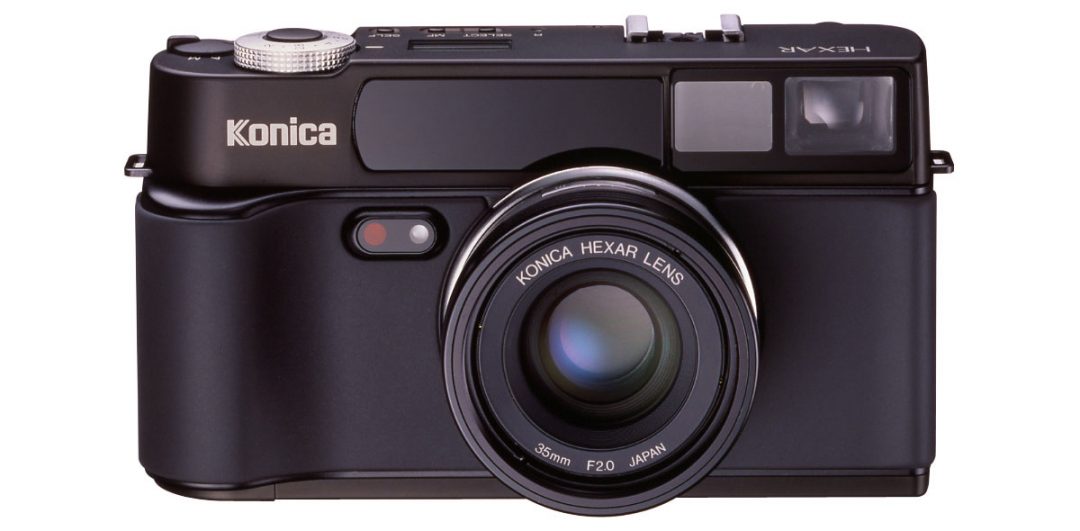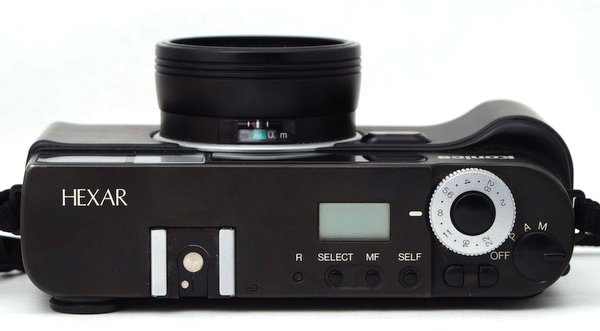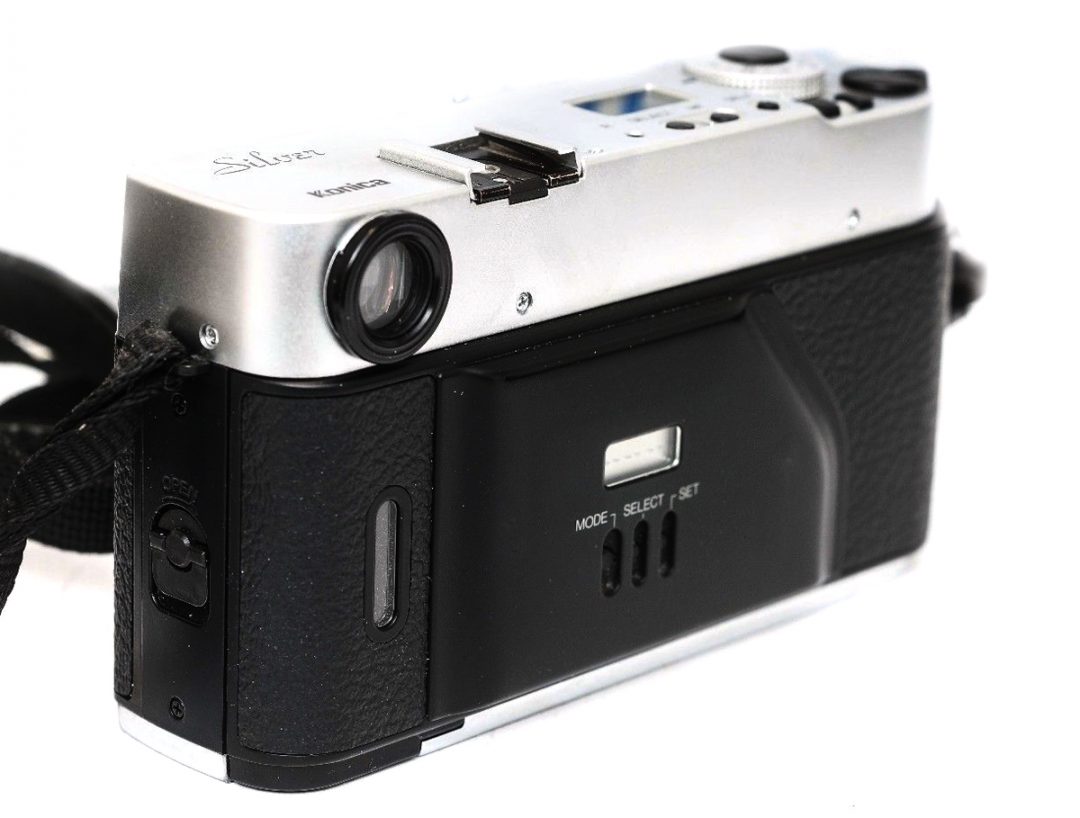Konica Hexar AF and Peter Lindbergh
The Konica Hexar AF (they have a manual focus one), is sort of a point and shoot because it’s fast, fits in your pocket and is not large and heavy. But not really. If I were to make direct comparisons, it would be with the Contax G1/G2,…or even a Leica M.
The first time I ever saw one was on the streets of NYC while doing a shoot. Almost directly across the street from me was Peter Lindbergh doing a shoot with Helena Christensen. While I could see he was using a Nikon F5 for the shoot, during stylist or lighting breaks, he was snapping away with another little camera. I asked an assistant, and he said it was a Konica Hexar AF,…Black. So I thought I should check it out. Did PL know something I didn’t know?

Now I get it. The Konica Hexar AF is like a Leica! The only thing that doesn’t put it in the same league is the fixed 35mm lens. (but the Hexar RF does have interchangeable lenses) So, if you have to have interchangeable lenses, this is not the camera for you. But sharpness and contrast? Holy mackerel! Silent? Ditto. If you love the 35mm focal length, you’ll love this camera.
Center Weighted Modes
It operates in one of 3 modes;: Program, Aperture preferred, and Manual.The Konica Hexar AF Program mode is pretty much like on every other camera. Except it allows you to control its biasing to aperture or shutter speed. Which is even better than Nikon or Canon cameras. So you even have control in Program mode. The top LCD tells you if your aperture or shutter speed are beyond light conditions!
Of course A and M modes gives you full control, and assumes you know what you’re doing. Another reason it’s not a point and shoot.
Cleverly, in P mode the top-deck LCD displays the shutter speed if the camera can use the aperture you set, but displays the aperture when it can’t (the shutter speed is at the max or user-set min so you don’t need to see it). This way of keeping the photographer informed while minimizing display clutter works well.
Weird Program Mode
Note that in P mode the Hexar will not use a shutter speed slower than the user-set minimum, even if it is required for proper exposure, but still takes the picture. While this prevents blur, it can lead to underexposure. The camera warns you of this by flashing the underexposure warning light in the finder and the LCD display on the top deck. You can set the minimum shutter speed as slow as 1/8, and there’s little reason to use P mode when not using the camera hand-held, so this isn’t a problem. The other exposure modes give you back full control when you want it.
Exposure
Shutter speed is as long as 30 seconds, and is even usable in P mode. Red plus and minus signs in the viewfinder is a very accurate exposure meter. In A and P mode, exposure lock can be accomplished with just a partial press on shutter release. No buttons or menus to navigate. When both plus and minus light up, you’re spot on exposure wise.
The shutter speed ranges from 30 seconds to 1/250 second. Totally user controllable. Something not possible with a Yashica T4, Contax T2, or even a Nikon 35Ti. It also allows you to set a minimum shutter speed between 1/8 to 1/60. The minus sign flashes if there is not enough light.
Flash
The flash is sort of a Contax TLA-200 in size. There are 2 made by Konica for this camera. The Hexar HX14 flash, (GN of 43 at 100 ISO), or you can use the HX18w. The camera can also communicate with any Nikon flash, but I’d stick to the smaller ones, like the SB-30. You don’t want a flash bigger than the camera. Flash is controlled at the flash,…not the camera. For the Konica flashes, there is a 5-10 second recycle. Yuck! And you’re controlling exposure through camera aperture, not the flash. This ain’t no 3-D Matrix metering. I say, “boo”, but it’s no big deal to some. At least it has an accessory hot shoe.
Another thing I don’t like is it has no PC connector. I think Konica was confused as to whether this would be a point and shoot or true rangefinder. And no redeye reduction.(but the flash is pretty far away from the lens, so probably not needed) It uses flashmatic, which is used by most point and shoots, but gives user controls found only on pro cameras. This is why most have a true love/hate relationship with this camera, and it’s not unusual to be scratching your head on some design features.
Autofocus
Autofocus? One of the best I’ve seen. The Konica Hexar AF can easily compete with a modern day Nikon or Canon. The multibeam system is extremely accurate, and you’ll find no complaints here. The manual focus version of this camera serves up no advantage. Unless you just like manual focusing. Like me. You can focus to within 2 feet. You can switch to manual focus with just the press of the ‘MF’ button on the top deck. And easily back to AF again. However, manual focusing is no Leica. But then I never liked it on my Contax G either.
The viewfinder is clear and accurate. It’s both bright and distortion free. The Konica Hexar AF viewfinder is not as good as a Leica M7, but miles ahead of the Contax G1/T2/T3, Yashica T4, or Nikon 35Ti. And there’s minimal ‘crap’ in the viewfinder, making the frame lines easy to see. And those same frame lines correct for parallax. Can you see my confusion in figuring out what category this camera fits in?
Autoload and rewind are smooth, as is the almost silent film advance. The quality of the camera is obvious in just film advance alone.
Well Built
The body is very well built and just feels good. And the lens is easily in the same stratosphere as Zeiss, Leica, and others. Except it’s fixed. Filters are 46mm, and since the front doesn’t rotate while focusing, polarizers are easy to use. Besides the excellent ergonomics, the “silent” mode is unbelievable! I don’t even think a Leica with a “blimp” can compare. It’s even super quiet when not in silent mode. To the extent that it’s startling on first use. Shutter lag? None. I know there’s some microsecond lag, but I cannot detect it. And since the lens is already in position from half press of shutter button, it doesn’t move when the picture is snapped.

The Good;
Sharp lens at f/2.0 and above. Cutting sharp at f/2.8 and above.
Accurate autofocus.
Maximum user control in all modes.
Compatible with Nikon flashes.
Clear and bright viewfinder and movable frame lines.
Shutter lag as short as any Leica.
Great ergonomics. Solid feel.
Silent!
Peter Lindbergh has one. (or had,…that was the late 90’s)
The Bad;
Slow max shutter speed. (1/250)
No PC connector. (yes, Contax G’s have a PC connector)
Uses “Flashmatic”,…old technology. However,…works well.
Not expensive, but not cheap. Case is extra.
Similar in size to Contax G1/G2,….may be good or bad.
No interchangeable lenses. (but, remember,…this is the Hexar, not Hexar RF)
Takes batteries. (as do all AF cameras)
No accommodation for cable release.
To Sum it Up
Whether using as a back-up camera, or your main camera, it’s a great camera at the price. Prices are about the same as Contax T2’s, but with a lot more control. Hell, if you are the kind of person that can shoot everything with a Yashica T4, then you can shoot everything with this camera. It’s not quite a Leica, but will produce images as sharp. Don’t forget to take the lens cap off! Find Konica Hexar





What do you mean theres little reason to use P mode when not shooting handheld? Confused to how this relates to the slowest shutter speed you can set since 1/8 handheld would be blurry.
Hi Art,
“Note that in P mode the Hexar will NOT use a shutter speed slower than the user-set minimum”. P mode enables the user to set minimum shutter speed, and takes care of all the other parameters of exposure. (as opposed to many other cameras, which are not smart enough to allow you to set that limitation in P mode) That’s all I meant.
Cheers
Great lens!